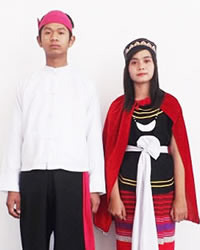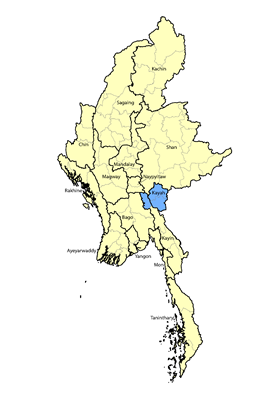Not to be confused with the similarly named Kayaw (Bwe Karen) people, the Kawyaw have been recognized as one of Myanmar's official ethnicities since the 1930s. Until recently most people have known them as the Manumanaw tribe, a label applied to them by the Burmese that “came about because of a lack of familiarity with local languages, causing errors in writing down local dialects and pronunciations in Burmese.” The tribe had never used that name to describe themselves, so in 2017 they agreed to formally refer to themselves as the Kawyaw rather than the incorrect government label that had long been used for them.
Location: With a population of 11,000 people spread over 23 villages in eastern Myanmar near the Thailand border, the Kawyaw people live in the Bawlakhe, Demoso, and Hpruso townships in Kayah State, and adjacent areas of Hpa-An District in northern Kayin (formerly Karen) State. Despite being the country's smallest state, Kayah is home to more than ten ethnic groups who inhabit a region of thick jungles, lakes, waterfalls, and towering mountains that rise up to 8,600 feet (2,620 meters) from the Salween River floor. Because of decades of armed conflict, the government effectively controls only a fraction of Kayah State.
Language: Kawyaw is a Central Kareni language in the Tibeto-Burman family, distinct from other varieties in this part of Myanmar including Kayah, Geba, Geko, and Padaung. One scholar noted: “The inter-relationships of these languages are not widely understood. Groups have often been better known by names used by outsiders. Even among Kareni peoples there are differences of opinion over how to classify different dialects or aspects of identity and culture.” Kawyaw has two subgroups, Tawkhu and Dolso, whose dialects are different enough that speakers from one group have trouble communicating with the other. Many Kawyaw people also use Burmese and S'gaw Karen as second languages. Kawyaw has been a written language using the Burmese script since 2011, although Catholics prefer to use an orthography based on the Roman alphabet that was first taught to them by missionaries.
Because of its strategic location as a gateway to Thailand and the prevalence of Christian tribes that refuse to submit to Burmese Buddhist culture, Kayah has seen much death and suffering. The state has been described as a place of “political impasse, a multiplicity of conflicting actors, contested natural resources, land grabbing, humanitarian suffering, and divided communities seeking to rebuild after more than six decades of civil war.”
Kawyaw community life revolves around agriculture and animal husbandry, as the people seek to eke out a living under difficult conditions. The main crops grown in the state are rice, millet, sesame, garlic, and groundnut. Minerals extracted from the land include tin, alabaster, and tungsten. The area was once famous for its teak and pine timber, but the forests have largely been stripped bare in recent decades due to illegal logging.
Catholic missionaries first arrived in the mid-19th century and converted many tribal people in Kayah and Kayin states, including among the Kawyaw. After Baptist missionaries reached the area, they were relieved to find people who were responsive to the Gospel, unlike the Buddhists on the plains. Looking back over a century or more of work among the Karen and Kayah tribes, the author of one report notes: “They were animists but believed in the existence of a creator and eternal God whom they did not really know…. The educational, medical, and literature work all reinforce the Karen Baptist movement. By 1852, there were 7,750 members in 76 churches. By the time the Karen celebrated the centennial in 1928, the membership had grown to 70,000”.
Today, almost all Kawyaw people are professing Christians, with the Baptist and Catholic denominations still dominant. For generations, Kawyaw believers operated without their own Bibles, but the New Testament was finally published in 2020, bringing light and understanding to the faith of many nominal Christians.
Scripture Prayers for the Kawyaw in Myanmar (Burma).
| Profile Source: Asia Harvest |











